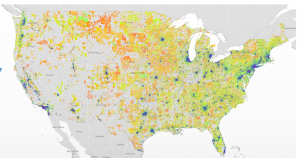
“Now is the time,” said Karen Cator, director of education technology at the Department of Education. “We’re at this incredible inflection point as we go from print to digital.”
Cator enumerated the ways in which the D.O.E. is helping to make the shift between the print and digital world at the ISTE conference yesterday.
1. TRANSPARENCY. Data.Ed.Gov is an interactive map that pintpoints which schools in the U.S. have broadband. It’s a collaboration with the Federal Communications Commission and the National Telecommunications and Inofrmation Administration. “If we can build those kinds of maps that we can layer on what’s happening in all these schools around country, that provides transparency and something that people can aspire to, follow,” Cator told me late last year.
2. DIGITAL LITERACY. DigitalLiteracy.gov was recently launched by a group of federal government agencies to help build computer and Internet skills, a free resource for anyone. A description from the site: “To provide librarians, teachers, workforce trainers, and others a central location to share digital literacy content and best practices. These trusted groups can, in turn, better reach out to their communities in providing them the skills today’s employers need.” Educators have their own dedicated link.
3. BRING YOUR OWN DEVICE ADVICE. For educators who want to find the best way to leverage their students’ devices, whether it’s their mobile phones or home laptops, CoSN’s newly launched Access4ed provides a host of resources about working experiments. From the site: “It will include conversations around key issues, case studies from districts addressing them, discussion of policy issues and how to address them, and opportunities to connect with education leaders in districts similar to and different from yours.”

